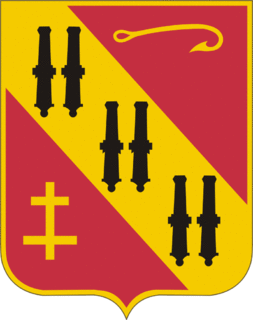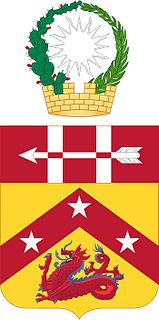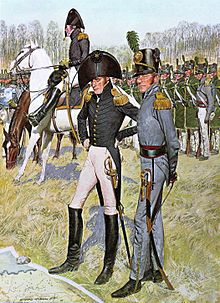Daniel Appling was an officer in the United States Army during the first two decades of the nineteenth century. He was born and educated in Columbia County, Georgia. After joining the Army at age eighteen, he was commissioned into the Regiment of Riflemen, in which he served for his entire career. He led troops in Florida during the Patriot war and along the Niagara frontier during the War of 1812. Appling resigned his commission in 1816 and moved to Alabama. Appling died in 1817. He died while the State of Georgia was procuring a sword to be presented to him in recognition of his service during the War of 1812. A county in Georgia is named after him and a U.S. Naval vessel after the county.
Benjamin Forsyth was an American officer of rifle troops in the War of 1812 between Britain and the United States. Born in North Carolina, Forsyth joined the United States Army in 1800 as an officer and was a captain of the Regiment of Riflemen at the outbreak of war in 1812. He led raids into Upper Canada along the Saint Lawrence River in 1812–13 before transferring south and taking part in the battles of York and Fort George. Promoted to brevet lieutenant colonel, he held a command along Lake Champlain. Forsyth was killed in June 1814 at Odelltown, Lower Canada.

The Maryland and Virginia Rifle Regiment, most commonly known as Rawlings' Regiment in period documents, was organized in June 1776 as a specialized light infantry unit of riflemen in the Continental Army during the American Revolutionary War. The American rifle units complemented the predominant, musket-equipped, line infantry forces of the war with their long-range marksmanship capability and were typically deployed with the line infantry as forward skirmishers and flanking elements. Scouting, escort, and outpost duties were also routine. The rifle units' battle formation was not nearly as structured as that of the line infantry units, which employed short-range massed firing in ordered linear formations. The riflemen could therefore respond with more adaptability to changing battle conditions.
The 2nd Infantry Regiment is an infantry regiment in the United States Army that has served for more than two hundred years. It was constituted on 12 April 1808 as the 6th Infantry and consolidated with 4 other regiments in 1815 to form the present unit.

The 5th Air Defense Artillery Regiment is an Air Defense Artillery regiment of the United States Army, first formed in 1861 in the Regular Army as the 5th Regiment of Artillery.

The 3rd Air Defense Artillery Regiment is an air defense artillery regiment of the United States Army first formed in 1821 as the 3rd Regiment of Artillery.
The 65th Air Defense Artillery was a training regiment in the United States Army. During World War I the unit was a tractor drawn (TD) unit equipped with British BL 9.2 inch Howitzers. When it was reactivated in Panama in 1924 it became an (AA) anti aircraft unit equipped with the 3-inch Gun M1918.
The 59th Coast Artillery Regiment, later the 59th Air Defense Artillery Regiment, was a regiment in the United States Army. It served as a heavy artillery regiment in France in World War I, and was in the Battle of Corregidor, Philippine Islands, in World War II.
Twenty-three currently active battalions of the Regular Army earned credit for campaigns during the War of 1812: two Air Defense Artillery battalions, six Field Artillery Battalions and seventeen Infantry battalions. These twenty-three battalions represent two Air Defense Artillery, four Field Artillery and seven Infantry regiments. Three additional Air Defense Artillery regiments have been awarded shared credit for War of 1812 campaigns, but the lineages of the artillery companies that earned those credits have not been perpetuated by currently active battalions.

Thomas Adams Smith was an American military officer and, later, a government official, in the first half of the 19th century. He commanded troops in the "Patriot War" in Spanish East Florida. He commanded the Regiment of Riflemen and then the Ninth Military Department. He was a slave owner. The city of Fort Smith, Arkansas, is named for Smith, although he never went to its location.

The 2nd Regiment of Riflemen was a unit of the U.S. Army in the early nineteenth century. It was first activated in 1814 during the War of 1812 when the War Department created three additional rifle regiments based on the success of the Regiment of Riflemen. The regiment was deactivated in May 1815.

The 3rd Regiment of Riflemen was a unit of the U.S. Army in the early nineteenth century. It was first activated in 1814 during the War of 1812 when the War Department created three additional rifle regiments based on the success of the Regiment of Riflemen. The regiment never fought and was deactivated in May 1815.
The Regiment of Light Dragoons was a unit of the U.S. Army in the early nineteenth century. It was first activated in 1808. During the War of 1812, it was temporarily designated as the 1st Regiment of Light Dragoons when the War Department created an additional similar regiment. On May 12, 1814, the additional regiment was consolidated with the 1st Regiment, which reverted to its unnumbered designation. The regiment was consolidated with the Corps of Artillery on May 17, 1815.
The 2nd Regiment of Light Dragoons was a unit of the U.S. Army in the early nineteenth century. It was first activated in 1812. The regiment was consolidated with the 1st Regiment of Light Dragoons on May 12, 1814, forming the Regiment of Light Dragoons.
Brevet Lieutenant Colonel Martin Scott was a career officer in the United States Army who was a signatory to the Treaty of St. Peters in 1837.
The 21st Coast Artillery Regiment was a regiment of the United States Army Coast Artillery Corps. It was the regular army component of the Harbor Defenses of the Delaware in World War II. The 21st CA (HD) Regiment was active from February 1940 until broken up in October 1944 as part of an Army-wide reorganization.
The 22nd Coast Artillery Regiment was a Coast Artillery regiment in the United States Army. It was the garrison of the Harbor Defenses of Portsmouth in World War II. The 22nd CA (HD) Regiment was active from February 1940 until broken up in March 1944 as part of an Army-wide reorganization.
The 24th Coast Artillery Regiment was a Coast Artillery regiment in the United States Army. It was the garrison of the Harbor Defenses of Argentia and St. John's, Newfoundland from February 1942 through October 1944, as a battalion after March 1943.
In the early years of the Republic, the United States Army experimented with a number of different artillery formations. For a time, the Artillery Branch and Engineer Branch were combined. Unit designations did not yet contain the terms "Field Artillery" or "Coast Artillery," although units so designated, as well those of the as air defense artillery units, would eventually trace their lineage and honors to some of the early formations.









